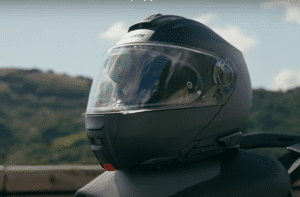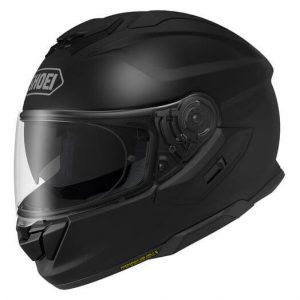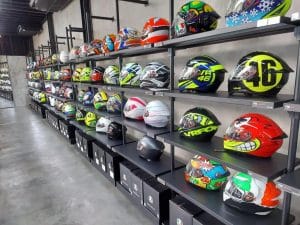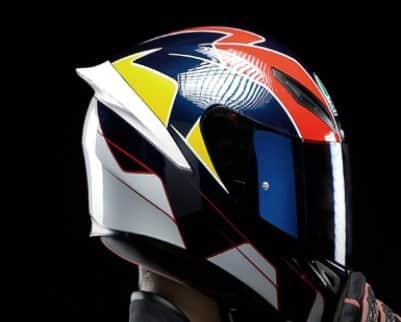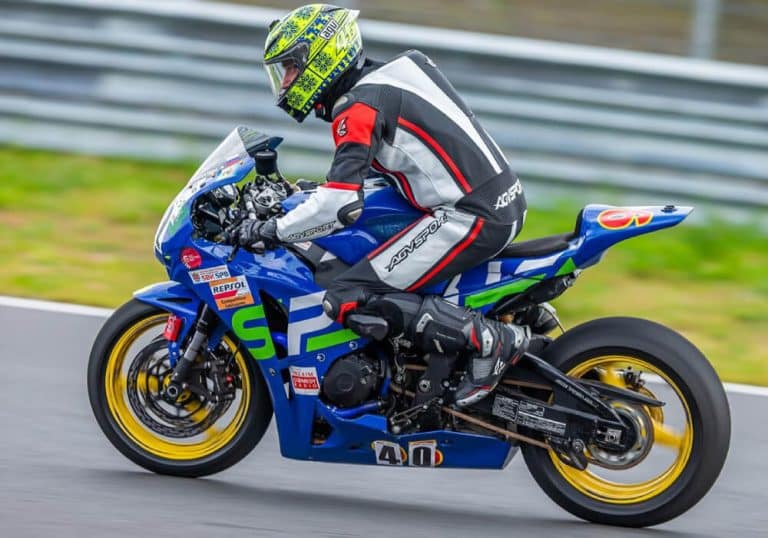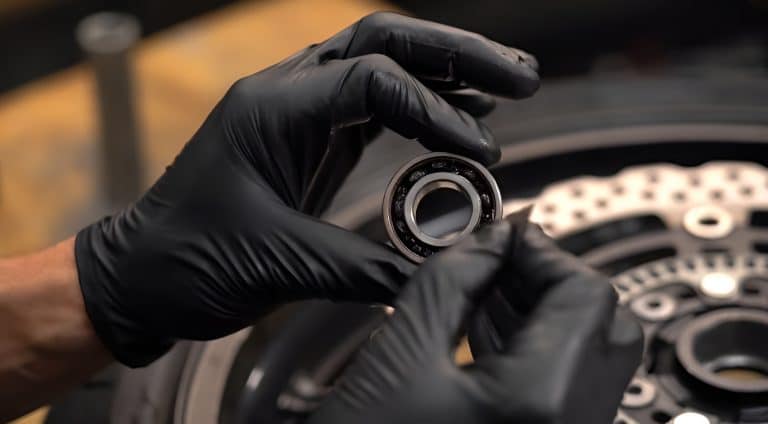Walking into Kawasaki’s Pavilion 11, Stand N46 at EICMA 2025 in Milan, the all-new 2026 Kawasaki Ninja ZX-10R instantly caught my eye. Under the show lights, it looked unmistakably sharper than the outgoing model. Its front end is dominated by bold projector headlights flanked by large, wing-like chin spoilers, giving it a “predatory” face that reinforces the next-generation Ninja family identity.
Kawasaki’s new lime-green and blue race-inspired livery also reinforces its WorldSBK heritage. Seeing the ZX-10R in person, the big winglets integrated into the cowl and aggressive bodywork promise a serious track focus, yet the overall stance reads as a race bike made road legal. Kawasaki clearly spent the off-season sharpening its supersport flagship.
After going through the press materials and seeing the bike up close, here is my first look:
Kawasaki Unveils the 2026 Ninja ZX-10R at EICMA 2025
Kawasaki officially unveiled the 2026 Ninja ZX-10R at EICMA on November 3, 2025, describing it as a focused update, one that pairs serious aerodynamic gains with subtle chassis and electronics refinements.

Unlike a full redesign, this update sharpens rather than replaces the outgoing model. The headline change is the new aerodynamic package: the fairing now incorporates large winglets that provide up to 25% more downforce to the front end. Engineers also tweaked the chassis geometry, for example, raising the swingarm pivot 2 mm to improve rear traction, and carried over the 998 cc inline-four engine with internal refinements for Euro5+ compliance.
Electronics get a big bump: a new 5-inch TFT dash (with turn-by-turn navigation via Kawasaki’s smartphone app) replaces the old display, and a Bosch 6-axis IMU now governs an advanced suite of rider aids. Traction control (KTRC), cornering ABS (KIBS), launch control, engine-brake control, and Kawasaki’s new Cornering Management Function (KCMF) are all standard, along with bi-directional Quickshifter (KQS) and even an Ohlins steering damper now included on the ZX-10R.
In short, Kawasaki promises sharper aerodynamics, a fine-tuned chassis, and state-of-the-art electronics to make the ZX-10R even more track-capable than before.
Key Updates Kawasaki Is Touting for 2026 Ninja ZX-10R S
To cut through Kawasaki’s press kit, here is what matters most:
| Category | Details | Rider Benefit |
| Engine | 998 cc liquid-cooled DOHC inline-4 (16 valves), Euro 5+ with dual O2 sensors, Retains 193 hp (143 kW) peak power | Same championship-calibre power with stronger low-/midrange torque, cleaner emissions, and smoother delivery |
| Aerodynamics & Styling | Integrated winglets and reshaped cowl, about 25% more downforce at speed | Better high-speed stability, more front grip on corner exit |
| Chassis Geometry | Revised aluminum twin-spar frame rake/offset and swingarm pivot raised 2 mm | Sharper turn-in and improved rear traction when powering out of corners |
| Suspension | 43 mm Showa Balance Free Front fork (revalved) and BFRC-lite rear shock (re-valved); Öhlins steering damper standard | WorldSBK-derived damping for greater stability, responsiveness, and track-focused ride quality |
| Brakes | Dual 330 mm Brembo M50 front calipers | Strong, precise stopping power |
| Electronics | Bosch 6-axis IMU with KIBS cornering ABS, 5-mode S-KTRC, KCMF, KLCM (launch control), KEBC | Precision rider aids that increase stability, safety, and confidence on both track and street |
| Quickshifter & Cruise | Bi-directional Kawasaki Quick Shifter; electronic cruise control (left-handlebar operated) | Smooth clutchless up/down shifts for faster laps and relaxed highway cruising |
| Display & Connectivity | New 5″ full-color TFT (IPS LCD, auto brightness); Bluetooth / RIDEOLOGY app integration | Modern, connected cockpit with turn-by-turn navigation, ride logging, and phone notifications |
| Wheels & Tires | Factory Bridgestone Battlax RS12 rubber | Faster warm-up and consistent grip in hot laps |
| Weight | Curb about 207 kg | Competitive handling balance for a liter-class superbike |
| Markets & price | Launched in India ~₹20.79 lakh (local pricing); EU/US pricing TBA | Premium positioning, details to be confirmed by region |
Kawasaki Ninja ZX-10R Engine and Performance
The 2026 ZX-10R keeps the proven 998 cc inline-four in place but with subtle internal tweaks for emissions and rideability. Kawasaki’s press release notes “refined” intake port machining and lighter titanium valves/pistons to preserve the engine’s free-revving nature.
A new second oxygen sensor enables Euro5+ compliance, so peak output is essentially unchanged from before (around 193 bhp at 13,000 rpm) while exhaust emissions are cleaner.
The big news is in the torque curve: Kawasaki says low- and mid-range pull is enhanced, giving stronger acceleration exiting corners. A ride-by-wire throttle (with an upgraded accelerator position sensor) replaces the old cable throttle, sharpening response. The slipper-clutch remains for smooth downshifts, and a full-range KQS (up/down) is standard for fast, clutchless shifts on track.
In practice, the ZX-10R’s engine should feel just as ferocious as before, but with a bit more tractability through bends and a race-ready feel at the top end.
Transmission and Electronics
Power flows through a 6-speed gearbox into a chain final drive, much like before. Kawasaki has kitted the ZX-10R with a superlative electronics suite, all coordinated by a 6-axis Bosch IMU. Integrated Riding Modes link S-KTRC (traction control) and Power Modes in three presets (Sport, Road, Rain) plus four fully custom modes.
Beyond that, the bike has cornering-ABS (KIBS) and Cornering Management Function (KCMF) to manage power and braking through turns, plus five levels of S-KTRC (with an off mode). Launch control (KLCM) with three settings and Kawasaki Engine Brake Control are available for track starts and throttle response tuning. Notably new for 2026 is full electronic cruise control, a rarity on a literbike, operable via buttons on the left grip.
All this data is presented on a new 5-inch TFT color display, larger than before. It features two display styles: a “street” mode with analogue-style tachometer and nav prompts, and a “track” mode with a bar tachometer and lap timer. Glass-bonding and IPS LCD technology give it wide viewing angles.
The TFT also shows all riding aids (modes, traction level, gear indicator, shift lights, etc.). Smartphone integration via Kawasaki’s RIDEOLOGY THE APP adds turn-by-turn navigation and call/message alerts directly to the screen.
In short, the ZX-10R now offers superbike-level rider aids and connectivity that make it as modern as it is fast.
Kawasaki Ninja ZX-10R Chassis and Suspension
The aluminum twin-spar frame is a carryover in concept but has been fine-tuned for the new aero package. Kawasaki shortened the trail by adjusting fork offset (for crisper turn-in) and raised the swingarm pivot by 2 mm to boost traction when powering out of corners.
The wheelbase remains 1450 mm, and rake is about 24.5°. Up front, a 43 mm Showa Balance Free Front (BFF) fork, derived from WorldSBK, is used, fully adjustable and newly re-valved for this model. The fork height is set slightly lower (0.2” down) than before to give a more neutral stance. In back is a Showa BFRC-lite horizontal back-link shock with piggyback reservoir, also re-valved and with a slightly softer spring (from 95 to 92.5 N/mm) for easier weight transfer.
Both ends have full preload, compression, and rebound adjustment. An Ohlins mechanical steering damper (twin-tube design) comes standard on all ZX-10R models now, providing consistent damping and reduced kickback at speed.
Overall, the suspension package is more track-focused than ever. Kawasaki claims the tuned damping, lighter spring rates, and new steering damper give riders increased stability and sharper turn-in without sacrificing cornering feel. From my quick look, the chassis looks ready to capitalize on the new aerodynamics, expect a balanced, planted feel on fast laps.
Brakes, Wheels, and Ergonomics
Stopping power is provided by Brembo M50 monobloc calipers on dual semi-floating 330 mm rotors up front, and a single 220 mm rotor with a 1-piston caliper at the rear. The Brembo setup (with a radial master cylinder) remains state-of-the-art for sportbikes.
Bridgestone’s new Battlax RS12 tires are fitted as standard, a 120/70-ZR17 front and 190/55-ZR17 rear, replacing the RS11 and offering quicker warm-up and added midcorner grip. The ZX-10R rolls on lightweight 3-spoke cast aluminum wheels designed for rigidity and track use.
I also noticed that the rider triangle is fully race-inspired. Clip-on bars sit well forward and low, and rear-set footpegs put the rider into a crouch behind the windscreen. The wind protection is generous for a supersport, thanks to the tall cowl and screen, so riders can tuck in deep.
The slimmed-down tank and bodywork allow knees to grip firmly for control. The seat height is 835 mm, high by street-bike standards, encouraging an aggressive tucked position. In short, there’s nothing here for comfort; every ergonomic choice favors aerodynamics and control on track.
Design-wise, Kawasaki has gone bold. The new hybrid LED projector headlights and “shark mouth” Ram-Air intake give the ZX-10R a menacing look. The fairings feature a sharp wedge profile flowing into the tail, and Kawasaki’s new lime/blue colorway highlights the bike’s angles and racing DNA. It’s an aggressive, modern look befitting the bike’s performance.
Kawasaki Ninja ZX-10R Availability and Pricing
Kawasaki announced the ZX-10R at EICMA and launched pricing for some markets. The model appeared in India with a listed price around ₹20.79 lakh (which converts to roughly US$24,000), while pricing and timing for Europe and North America are pending. Kawasaki typically staggers regional release dates, so final availability and local MSRP will be confirmed by regional dealers.
Kawasaki Ninja ZX-10R First Impressions: Strengths and Potential Drawbacks
Strengths:
- Aerodynamic Aggression: The new front fairing and winglets deliver real downforce for high-speed stability, a rare feature on production superbikes.
- Advanced Electronics: An unparalleled array of rider aids (6-axis IMU, cornering ABS/TC, launch control, adjustable engine-brake, cruise control, and more gives expert-level control on track.
- Powerful, Tuned Engine: The proven 998 cc four-cylinder retains its firepower (193 bhp) and strong torque. Revisions for Euro5+ and improved mid-range make it more tractable out of corners.
- Race-Ready Chassis: WorldSBK-derived suspension components and Brembo brakes mean exceptional handling and stopping power. The Ohlins steering damper adds high-speed confidence.
- Modern Cockpit: The large TFT display with navigation and smartphone connectivity is very user-friendly. Kawasaki’s Race-oriented display options (lap timer, shift lights) cater to enthusiasts.
Potential Drawbacks:
- Steep Learning Curve: With so many systems, novice riders may be overwhelmed. Tracking down and integrating firmware or updates (via the app) could also be a hassle.
- High Price/Weight: The ZX-10R remains a niche race replica; it’s heavy (207 kg wet) and expensive. Competing literbikes now often match or exceed its tech, so the ZX-10R must justify its premium.
- Conservative Power Bump: Kawasaki didn’t hike peak output, relying on chassis/aero gains. Riders expecting a horsepower leap may be slightly disappointed that the number (193 bhp) is essentially the same as before.
- Aggressive Ergonomics: As a pure track machine, it’s not very comfortable for street use. The tall seat and crouched position may fatigue all-day riders.
Overall, the 2026 Ninja ZX-10R looks like a serious evolution of Kawasaki’s flagship superbike. It tightens up everything without altering the ZX-10R’s core identity: a brawny, track-focused machine. The biggest question is whether it’s new tech and aero translates to faster lap times (versus competitors). For riders, like myself, obsessed with circuit performance, the ZX-10R offers a compelling package, but casual riders may find the upgrades overwhelming or extraneous.
2026 Kawasaki Ninja ZX-10R Full Specifications
Below is a summary of the ZX-10R’s core specs for 2026:
| Category | Specification |
| Engine | 998cc liquid-cooled 4-stroke DOHC inline-4 (16-valve) |
| Bore × Stroke | 76.0 × 55.0 mm |
| Compression Ratio | 13.0: 1 |
| Valves | 4 per cylinder |
| Power | 193 hp (143 kW) @ 13,000 rpm |
| Torque | 112 Nm (82.6 lb‑ft) @ 11,500 rpm |
| Fuel System | Electronic fuel injection (ride-by-wire) |
| Transmission | 6-speed, wet multiplate slipper clutch |
| Final Drive | Chain drive |
| Frame | Aluminum twin-spar (tubular diamond) |
| Front Suspension | ø43 mm Showa Balance Free Front fork, fully adjustable |
| Rear Suspension | Showa BFRC-lite horizontal back-link shock, fully adjustable |
| Front Brakes | Dual 330 mm discs, Brembo M50 4-piston radially mounted calipers |
| Rear Brake | Single 220 mm disc, 1-piston caliper |
| Wheels (F/R) | Cast 3-spoke aluminum, 17×3.50″ & 17×6.00″ |
| Tires (F/R) | 120/70-ZR17 & 190/55-ZR17 Bridgestone Battlax RS12 |
| Electronics | 5″ TFT display; Bosch 6-axis IMU; KIBS cornering ABS; 5-mode KTRC; KCMF; KLCM (launch control); cruise control; Kawasaki Engine Brake Control; Bluetooth connectivity |
| Seat Height | 835 mm |
| Fuel Capacity | 17.0 L |
| Wet Weight | 207 kg |
Information for this article was partially sourced and researched from the following authoritative government, educational, corporate, and non-profit organizations:
M/A



